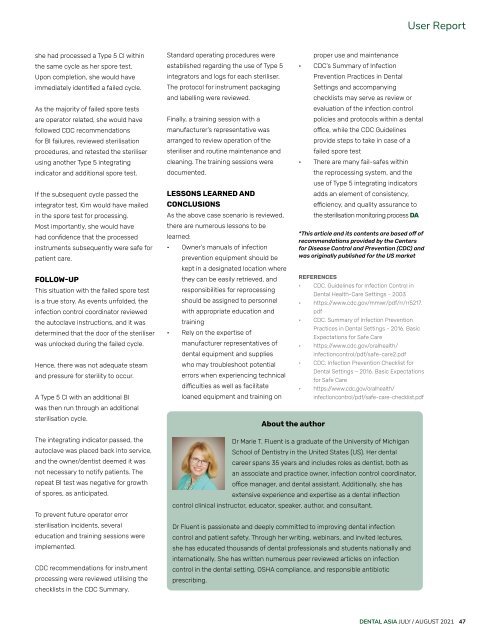Dental Asia July/August 2021
For more than two decades, Dental Asia is the premium journal in linking dental innovators and manufacturers to its rightful audience. We devote ourselves in showcasing the latest dental technology and share evidence-based clinical philosophies to serve as an educational platform to dental professionals. Our combined portfolio of print and digital media also allows us to reach a wider market and secure our position as the leading dental media in the Asia Pacific region while facilitating global interactions among our readers.
For more than two decades, Dental Asia is the premium journal in linking dental innovators and manufacturers to its rightful audience. We devote ourselves in showcasing the latest dental technology and share evidence-based clinical philosophies to serve as an educational platform to dental professionals. Our combined portfolio of print and digital media also allows us to reach a wider market and secure our position as the leading dental media in the Asia Pacific region while facilitating global interactions among our readers.
Create successful ePaper yourself
Turn your PDF publications into a flip-book with our unique Google optimized e-Paper software.
User Report<br />
she had processed a Type 5 CI within<br />
the same cycle as her spore test.<br />
Upon completion, she would have<br />
immediately identified a failed cycle.<br />
As the majority of failed spore tests<br />
are operator related, she would have<br />
followed CDC recommendations<br />
for BI failures, reviewed sterilisation<br />
procedures, and retested the steriliser<br />
using another Type 5 integrating<br />
indicator and additional spore test.<br />
If the subsequent cycle passed the<br />
integrator test, Kim would have mailed<br />
in the spore test for processing.<br />
Most importantly, she would have<br />
had confidence that the processed<br />
instruments subsequently were safe for<br />
patient care.<br />
FOLLOW-UP<br />
This situation with the failed spore test<br />
is a true story. As events unfolded, the<br />
infection control coordinator reviewed<br />
the autoclave instructions, and it was<br />
determined that the door of the steriliser<br />
was unlocked during the failed cycle.<br />
Hence, there was not adequate steam<br />
and pressure for sterility to occur.<br />
A Type 5 CI with an additional BI<br />
was then run through an additional<br />
sterilisation cycle.<br />
The integrating indicator passed, the<br />
autoclave was placed back into service,<br />
and the owner/dentist deemed it was<br />
not necessary to notify patients. The<br />
repeat BI test was negative for growth<br />
of spores, as anticipated.<br />
To prevent future operator error<br />
sterilisation incidents, several<br />
education and training sessions were<br />
implemented.<br />
CDC recommendations for instrument<br />
processing were reviewed utilising the<br />
checklists in the CDC Summary.<br />
Standard operating procedures were<br />
established regarding the use of Type 5<br />
integrators and logs for each steriliser.<br />
The protocol for instrument packaging<br />
and labelling were reviewed.<br />
Finally, a training session with a<br />
manufacturer’s representative was<br />
arranged to review operation of the<br />
steriliser and routine maintenance and<br />
cleaning. The training sessions were<br />
documented.<br />
LESSONS LEARNED AND<br />
CONCLUSIONS<br />
As the above case scenario is reviewed,<br />
there are numerous lessons to be<br />
learned:<br />
• Owner’s manuals of infection<br />
prevention equipment should be<br />
kept in a designated location where<br />
they can be easily retrieved, and<br />
responsibilities for reprocessing<br />
should be assigned to personnel<br />
with appropriate education and<br />
training<br />
• Rely on the expertise of<br />
manufacturer representatives of<br />
dental equipment and supplies<br />
who may troubleshoot potential<br />
errors when experiencing technical<br />
difficulties as well as facilitate<br />
loaned equipment and training on<br />
About the author<br />
Dr Marie T. Fluent is a graduate of the University of Michigan<br />
School of Dentistry in the United States (US). Her dental<br />
career spans 35 years and includes roles as dentist, both as<br />
an associate and practice owner, infection control coordinator,<br />
office manager, and dental assistant. Additionally, she has<br />
extensive experience and expertise as a dental inflection<br />
control clinical instructor, educator, speaker, author, and consultant.<br />
Dr Fluent is passionate and deeply committed to improving dental infection<br />
control and patient safety. Through her writing, webinars, and invited lectures,<br />
she has educated thousands of dental professionals and students nationally and<br />
internationally. She has written numerous peer reviewed articles on infection<br />
control in the dental setting, OSHA compliance, and responsible antibiotic<br />
prescribing.<br />
proper use and maintenance<br />
• CDC’s Summary of Infection<br />
Prevention Practices in <strong>Dental</strong><br />
Settings and accompanying<br />
checklists may serve as review or<br />
evaluation of the infection control<br />
policies and protocols within a dental<br />
office, while the CDC Guidelines<br />
provide steps to take in case of a<br />
failed spore test<br />
• There are many fail-safes within<br />
the reprocessing system, and the<br />
use of Type 5 integrating indicators<br />
adds an element of consistency,<br />
efficiency, and quality assurance to<br />
the sterilisation monitoring process DA<br />
*This article and its contents are based off of<br />
recommendations provided by the Centers<br />
for Disease Control and Prevention (CDC) and<br />
was originally published for the US market<br />
REFERENCES<br />
• CDC. Guidelines for Infection Control in<br />
<strong>Dental</strong> Health-Care Settings - 2003<br />
• https://www.cdc.gov/mmwr/pdf/rr/rr5217.<br />
pdf<br />
• CDC. Summary of Infection Prevention<br />
Practices in <strong>Dental</strong> Settings - 2016. Basic<br />
Expectations for Safe Care<br />
• https://www.cdc.gov/oralhealth/<br />
infectioncontrol/pdf/safe-care2.pdf<br />
• CDC. Infection Prevention Checklist for<br />
<strong>Dental</strong> Settings – 2016. Basic Expectations<br />
for Safe Care<br />
• https://www.cdc.gov/oralhealth/<br />
infectioncontrol/pdf/safe-care-checklist.pdf<br />
DENTAL ASIA JULY / AUGUST <strong>2021</strong> 47


















